2011 Peugeot 308 SW BL tow
[x] Cancel search: towPage 5 of 356

3
CONTENTS
Direction indicators 135
Hazard warning lamps 135
Horn 135
Tyre under-infl ation detection 136
Emergency or assistance call 137
Braking assistance systems 137
Trajectory control systems 138
Front seat belts 139
Airbags 144�„
�„
�„
�„
�„
�„
�„
�„
�„
SAFETY 135 �Π147
Parking brake 148
Manual gearbox 148
Gear shift indicator 149
Hill start assist 150
6-speed electronic
gear control gearbox 151
Automatic gearbox 155
Stop & Start 158
Speed limiter 161
Cruise control 163
Parking sensors 165�„
�„
�„
�„
�„
�„
�„
�„
�„
�„
DRIVING 148 �Π166
Bonnet 168
Running out of fuel (Diesel) 169
Petrol engines 170
Diesel engines 171
Checking levels 172
Checks 174�„
�„
�„
�„
�„
�„
CHECKS 167 �Π175
Temporary puncture
repair kit 176
Changing a wheel 184
Changing a bulb 191
Changing a fuse 198
Battery 204
Energy economy mode 206
Changing a wiper blade 207
Towing the vehicle 207
Towing a trailer 210
Very cold climate screen 211
Fitting roof bars 212
Accessories 213�„
�„
�„
�„
�„
�„
�„
�„
�„
�„
�„
�„
PRACTICAL
INFORMATION 176 �Π214
Petrol engines 215
Petrol weights 218
Diesel engines 224
Masses Diesel 227
Dimensions 236
Identifi cation markings 237�„
�„
�„
�„
�„
�„
TECHNICAL
DATA 215 �Π238
AUDIO EQUIPMENT
and TELEMATICS 239 �Π338
VISUAL SEARCH 339 �Π345
ALPHABETICAL
INDEX 346 �Π350
Emergency or assistance 239
Peugeot Connect Media 243
Peugeot Connect Navigation 287
Peugeot Connect Sound 319�„
�„
�„
�„
8
910
1112
Page 25 of 356
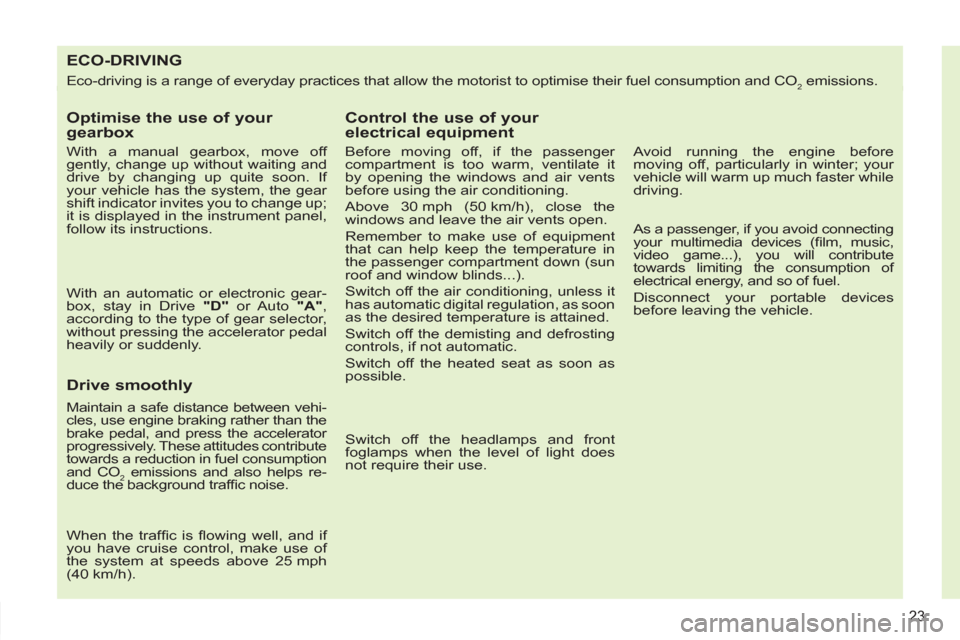
ECO-DRIVING
Eco-driving is a range of everyday practices that allow the motorist to optimise their fuel consumption and CO2 emissions.
Optimise the use of your
gearbox
With a manual gearbox, move off
gently, change up without waiting and
drive by changing up quite soon. If
your vehicle has the system, the gear
shift indicator invites you to change up;
it is displayed in the instrument panel,
follow its instructions.
With an automatic or electronic gear-
box, stay in Drive "D"
or Auto "A"
,
according to the type of gear selector,
without pressing the accelerator pedal
heavily or suddenly.
Drive smoothly
Maintain a safe distance between vehi-
cles, use engine braking rather than the
brake pedal, and press the accelerator
progressively. These attitudes contribute
towards a reduction in fuel consumption
and CO
2 emissions and also helps re-
duce the background traffi c noise.
When the traffi c is fl owing well, and if
you have cruise control, make use of
the system at speeds above 25 mph
(40 km/h).
Control the use of your
electrical equipment
Before moving off, if the passenger
compartment is too warm, ventilate it
by opening the windows and air vents
before using the air conditioning.
Above 30 mph (50 km/h), close the
windows and leave the air vents open.
Remember to make use of equipment
that can help keep the temperature in
the passenger compartment down (sun
roof and window blinds...).
Switch off the air conditioning, unless it
has automatic digital regulation, as soon
as the desired temperature is attained.
Switch off the demisting and defrosting
controls, if not automatic.
Switch off the heated seat as soon as
possible.
Switch off the headlamps and front
foglamps when the level of light does
not require their use.
Avoid running the engine before
moving off, particularly in winter; your
vehicle will warm up much faster while
driving.
As a passenger, if you avoid connecting
your multimedia devices (fi lm, music,
video game...), you will contribute
towards limiting the consumption of
electrical energy, and so of fuel.
Disconnect your portable devices
before leaving the vehicle.
23
Page 34 of 356

1
32
INSTRUMENTS and CONTROLS
Low fuel level
fi xed with the
needle in the
red zone,
accompanied
by an audible
signal and a
message. When it fi rst comes on there
remains approximately
6 litres
of fuel in the tank.
At this point, you begin to
use the fuel reserve. Refuel as soon as possible to avoid running out
of fuel.
Until suffi cient fuel has been added, this warning
lamp will come on every time the ignition is
switched on, accompanied by an audible signal
and a message.
This audible signal and message are repeated
with increasing frequency as the fuel level drops
towards "0"
.
Fuel tank capacity: approximately 60 litres
.
Never continue to drive until you run out of fuel,
as this could damage the emission control and
injection systems.
Warning lamp
is on
Cause
Action/Observations
Anti-lock
Braking
System
(ABS)
fi xed. The anti-lock braking
system has a fault. The vehicle retains conventional braking.
Drive carefully at reduced speed and contact
a PEUGEOT dealer or a qualifi ed workshop
without delay.
Dynamic
stability
control
(ESP/ASR)
fl ashing. The ESP/ASR regulation is
active. The system optimises traction and improves the
directional stability of the vehicle.
fi xed. Unless it has been
deactivated (button pressed
and its indicator lamp on) the
ESP/ASR system has a fault. Have it checked by a PEUGEOT or a qualifi ed
workshop.
Directional
headlamps
fl ashing. The directional headlamps
system has a fault. Have it checked by a PEUGEOT dealer or a
qualifi ed workshop.
Foot on the
brake pedal
fi xed. You have forgotten to press
the brake pedal when
starting the engine, with
an electronic gear control
gearbox. You have to press the brake pedal to start the
engine (gear lever in position N
).
Page 38 of 356
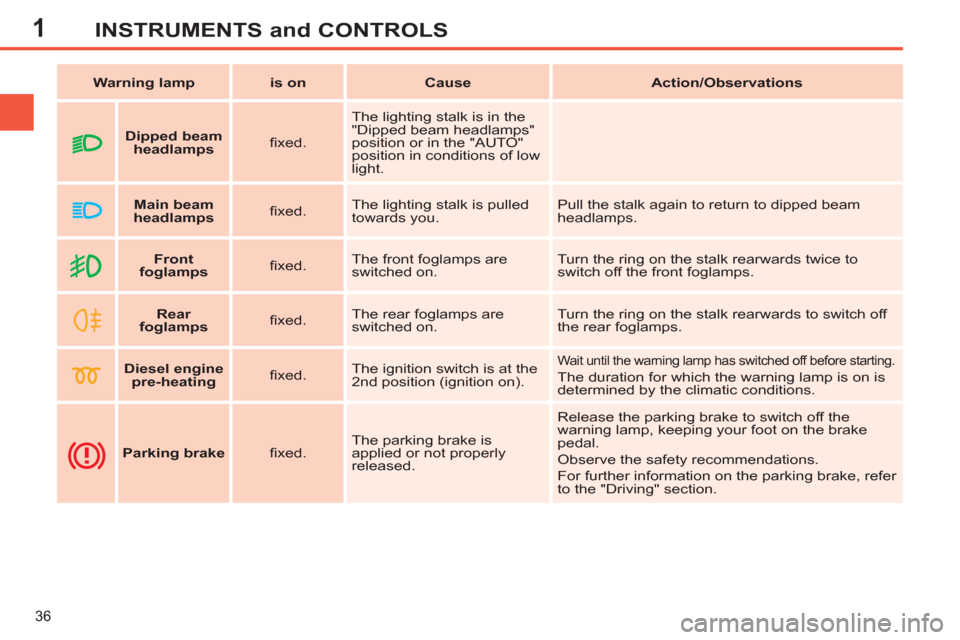
1
36
INSTRUMENTS and CONTROLS
Warning lamp
is on
Cause
Action/Observations
Front
foglamps
fi xed. The front foglamps are
switched on. Turn the ring on the stalk rearwards twice to
switch off the front foglamps.
Rear
foglamps
fi xed. The rear foglamps are
switched on. Turn the ring on the stalk rearwards to switch off
the rear foglamps.
Diesel engine
pre-heating
fi xed. The ignition switch is at the
2nd position (ignition on).
Wait until the warning lamp has switched off before starting.
The duration for which the warning lamp is on is
determined by the climatic conditions.
Parking brake
fi xed. The parking brake is
applied or not properly
released. Release the parking brake to switch off the
warning lamp, keeping your foot on the brake
pedal.
Observe the safety recommendations.
For further information on the parking brake, refer
to the "Driving" section.
Dipped beam
headlamps
fi xed. The lighting stalk is in the
"Dipped beam headlamps"
position or in the "AUTO"
position in conditions of low
light.
Main beam
headlamps
fi xed. The lighting stalk is pulled
towards you. Pull the stalk again to return to dipped beam
headlamps.
Page 58 of 356
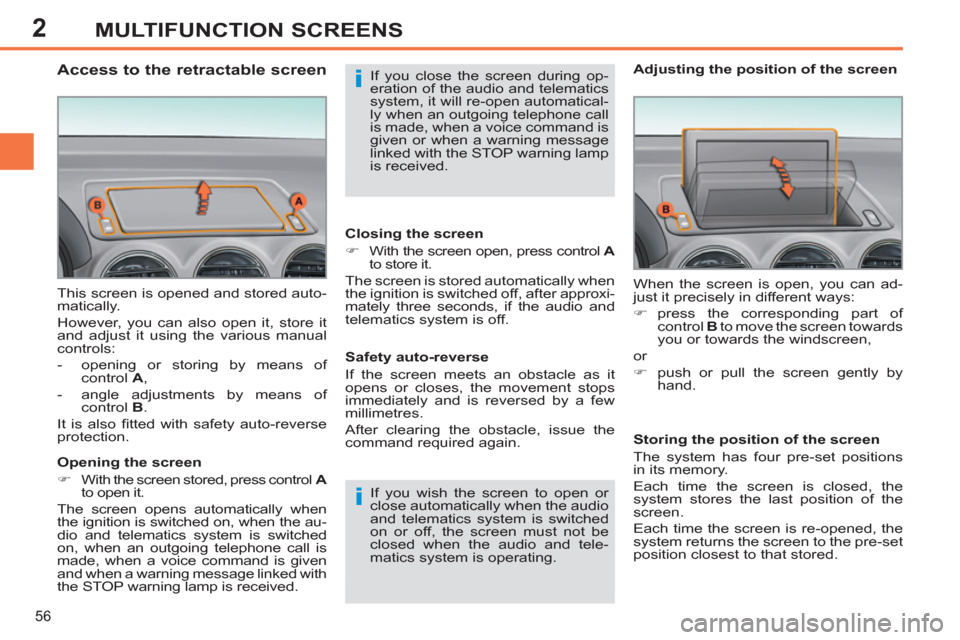
2
i
i
56
MULTIFUNCTION SCREENS
This screen is opened and stored auto-
matically.
However, you can also open it, store it
and adjust it using the various manual
controls:
- opening or storing by means of
control A
,
- angle adjustments by means of
control B
.
It is also fi tted with safety auto-reverse
protection.
Opening the screen
�)
With the screen stored, press control A
to open it.
The screen opens automatically when
the ignition is switched on, when the au-
dio and telematics system is switched
on, when an outgoing telephone call is
made, when a voice command is given
and when a warning message linked with
the STOP warning lamp is received.
Closing the screen
�)
With the screen open, press control A
to store it.
The screen is stored automatically when
the ignition is switched off, after approxi-
mately three seconds, if the audio and
telematics system is off.
If you wish the screen to open or
close automatically when the audio
and telematics system is switched
on or off, the screen must not be
closed when the audio and tele-
matics system is operating. When the screen is open, you can ad-
just it precisely in different ways:
�)
press the corresponding part of
control B
to move the screen towards
you or towards the windscreen,
or
�)
push or pull the screen gently by
hand.
Adjusting the position of the screen
Safety auto-reverse
If the screen meets an obstacle as it
opens or closes, the movement stops
immediately and is reversed by a few
millimetres.
After clearing the obstacle, issue the
command required again.
Storing the position of the screen
The system has four pre-set positions
in its memory.
Each time the screen is closed, the
system stores the last position of the
screen.
Each time the screen is re-opened, the
system returns the screen to the pre-set
position closest to that stored.
If you close the screen during op-
eration of the audio and telematics
system, it will re-open automatical-
ly when an outgoing telephone call
is made, when a voice command is
given or when a warning message
linked with the STOP warning lamp
is received.
Access to the retractable screen
Page 64 of 356
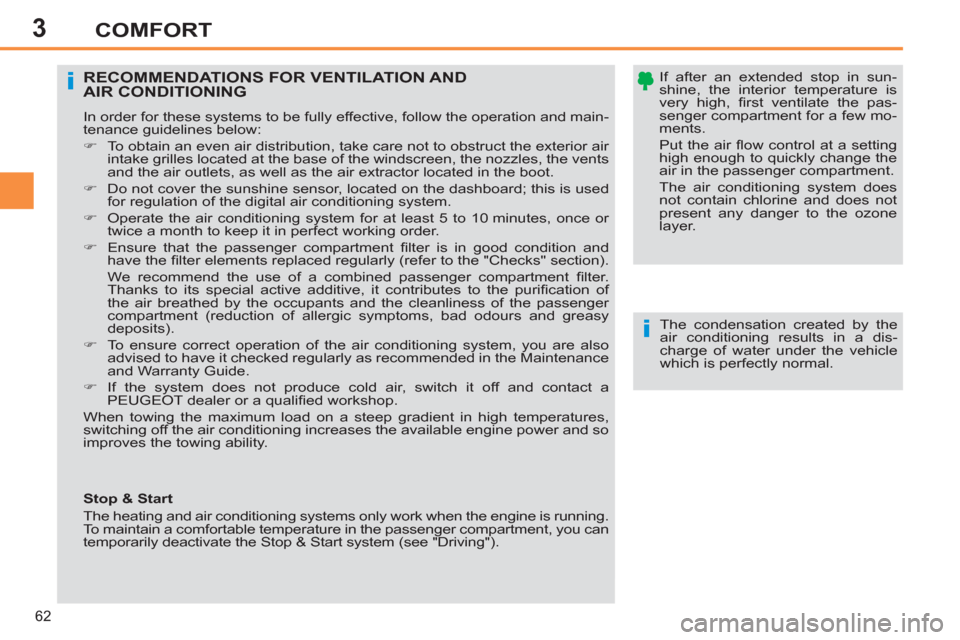
3
i
i
62
COMFORT
If after an extended stop in sun-
shine, the interior temperature is
very high, fi rst ventilate the pas-
senger compartment for a few mo-
ments.
Put the air fl ow control at a setting
high enough to quickly change the
air in the passenger compartment.
The air conditioning system does
not contain chlorine and does not
present any danger to the ozone
layer.
RECOMMENDATIONS FOR VENTILATION AND
AIR CONDITIONING
In order for these systems to be fully effective, follow the operation and main-
tenance guidelines below:
�)
To obtain an even air distribution, take care not to obstruct the exterior air
intake grilles located at the base of the windscreen, the nozzles, the vents
and the air outlets, as well as the air extractor located in the boot.
�)
Do not cover the sunshine sensor, located on the dashboard; this is used
for regulation of the digital air conditioning system.
�)
Operate the air conditioning system for at least 5 to 10 minutes, once or
twice a month to keep it in perfect working order.
�)
Ensure that the passenger compartment fi lter is in good condition and
have the fi lter elements replaced regularly (refer to the "Checks" section).
We recommend the use of a combined passenger compartment fi lter.
Thanks to its special active additive, it contributes to the purifi cation of
the air breathed by the occupants and the cleanliness of the passenger
compartment (reduction of allergic symptoms, bad odours and greasy
deposits).
�)
To ensure correct operation of the air conditioning system, you are also
advised to have it checked regularly as recommended in the Maintenance
and Warranty Guide.
�)
If the system does not produce cold air, switch it off and contact a
PEUGEOT dealer or a qualifi ed workshop.
When towing the maximum load on a steep gradient in high temperatures,
switching off the air conditioning increases the available engine power and so
improves the towing ability.
The condensation created by the
air conditioning results in a dis-
charge of water under the vehicle
which is perfectly normal.
Stop & Start
The heating and air conditioning systems only work when the engine is running.
To maintain a comfortable temperature in the passenger compartment, you can
temporarily deactivate the Stop & Start system (see "Driving").
Page 87 of 356
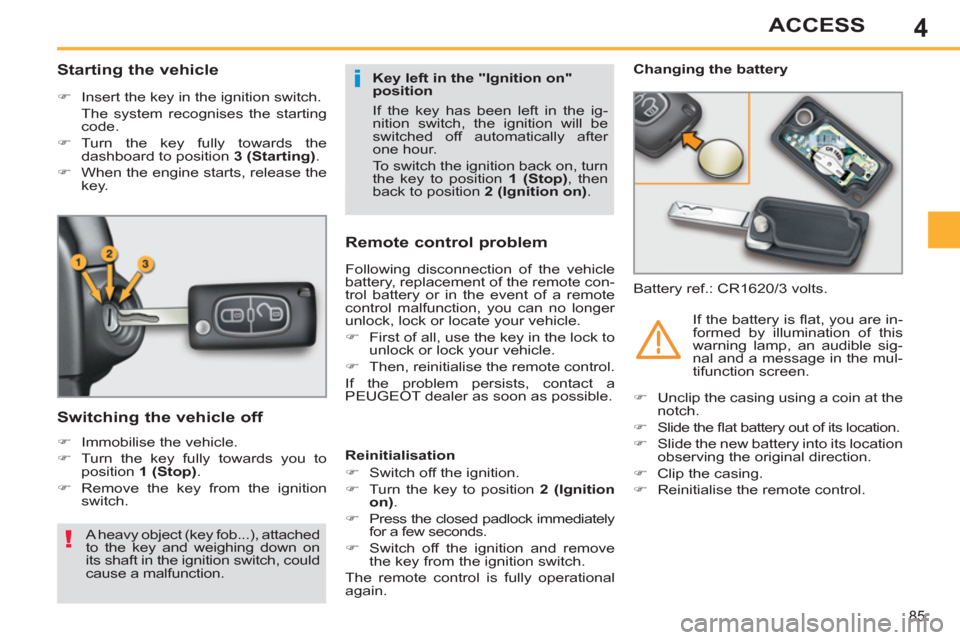
4
i
!
85
ACCESS
Starting the vehicle
�)
Insert the key in the ignition switch.
The system recognises the starting
code.
�)
Turn the key fully towards the
dashboard to position 3 (Starting)
.
�)
When the engine starts, release the
key.
Switching the vehicle off
�)
Immobilise the vehicle.
�)
Turn the key fully towards you to
position 1 (Stop)
.
�)
Remove the key from the ignition
switch.
Remote control problem
Following disconnection of the vehicle
battery, replacement of the remote con-
trol battery or in the event of a remote
control malfunction, you can no longer
unlock, lock or locate your vehicle.
�)
First of all, use the key in the lock to
unlock or lock your vehicle.
�)
Then, reinitialise the remote control.
If the problem persists, contact a
PEUGEOT dealer as soon as possible.
Changing the battery
Battery ref.: CR1620/3 volts.
Reinitialisation
�)
Switch off the ignition.
�)
Turn the key to position 2 (Ignition
on)
.
�)
Press the closed padlock immediately
for a few seconds.
�)
Switch off the ignition and remove
the key from the ignition switch.
The remote control is fully operational
again. If the battery is fl at, you are in-
formed by illumination of this
warning lamp, an audible sig-
nal and a message in the mul-
tifunction screen.
Key left in the "Ignition on"
position
If the key has been left in the ig-
nition switch, the ignition will be
switched off automatically after
one hour.
To switch the ignition back on, turn
the key to position 1 (Stop)
, then
back to position 2 (Ignition
on
)
.
�)
Unclip the casing using a coin at the
notch.
�)
Slide the fl at battery out of its location.
�)
Slide the new battery into its location
observing the original direction.
�)
Clip the casing.
�)
Reinitialise the remote control.
A heavy object (key fob...), attached
to the key and weighing down on
its shaft in the ignition switch, could
cause a malfunction.
Page 95 of 356
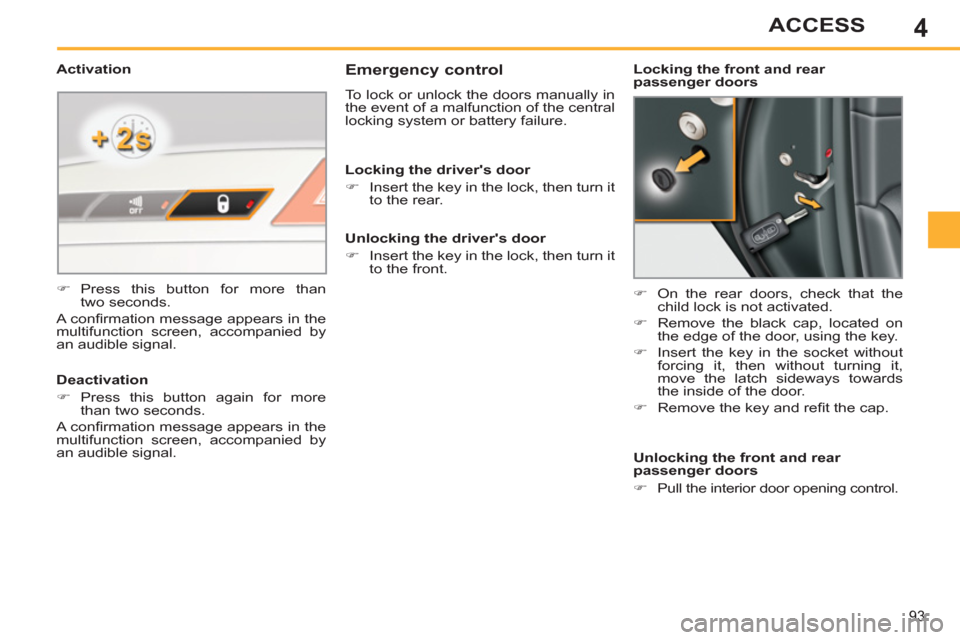
4
93
ACCESS
Emergency control
To lock or unlock the doors manually in
the event of a malfunction of the central
locking system or battery failure.
�)
On the rear doors, check that the
child lock is not activated.
�)
Remove the black cap, located on
the edge of the door, using the key.
�)
Insert the key in the socket without
forcing it, then without turning it,
move the latch sideways towards
the inside of the door.
�)
Remove the key and refi t the cap.
Locking the driver's door
�)
Insert the key in the lock, then turn it
to the rear.
Unlocking the driver's door
�)
Insert the key in the lock, then turn it
to the front.
Locking the front and rear
passenger doors
Unlocking the front and rear
passenger doors
�)
Pull the interior door opening control.
Activation
�)
Press this button for more than
two seconds.
A confi rmation message appears in the
multifunction screen, accompanied by
an audible signal.
Deactivation
�)
Press this button again for more
than two seconds.
A confi rmation message appears in the
multifunction screen, accompanied by
an audible signal.